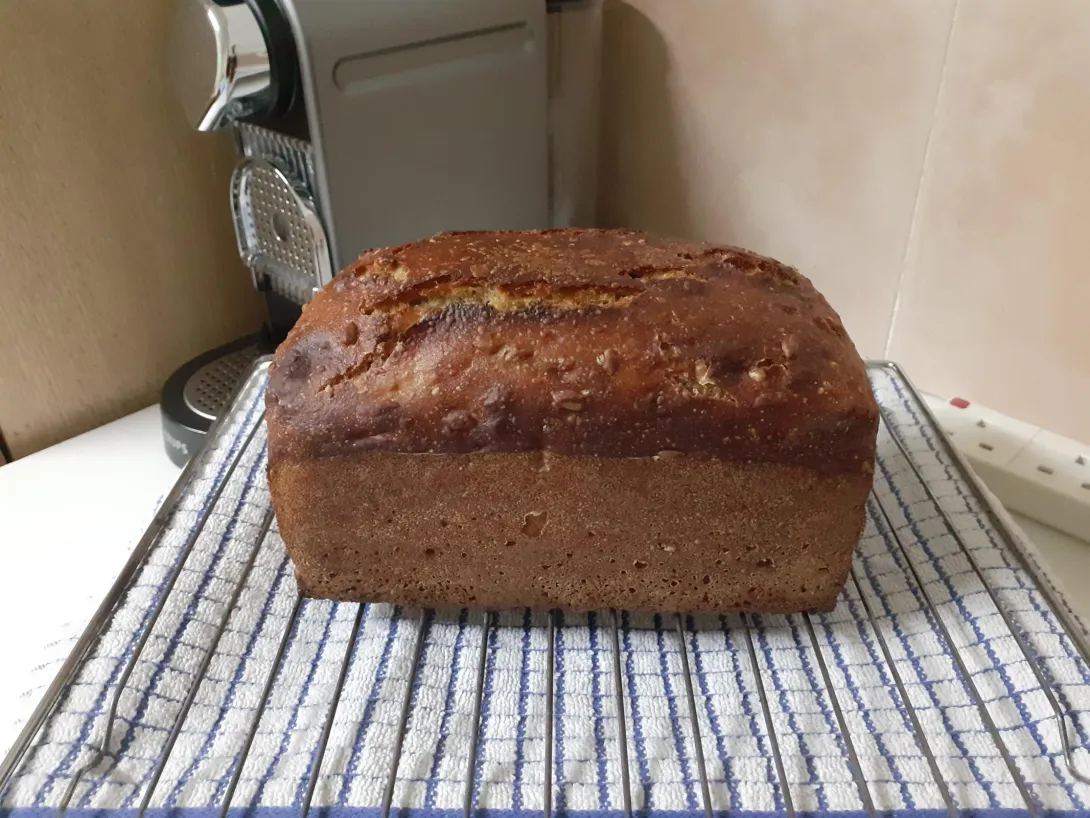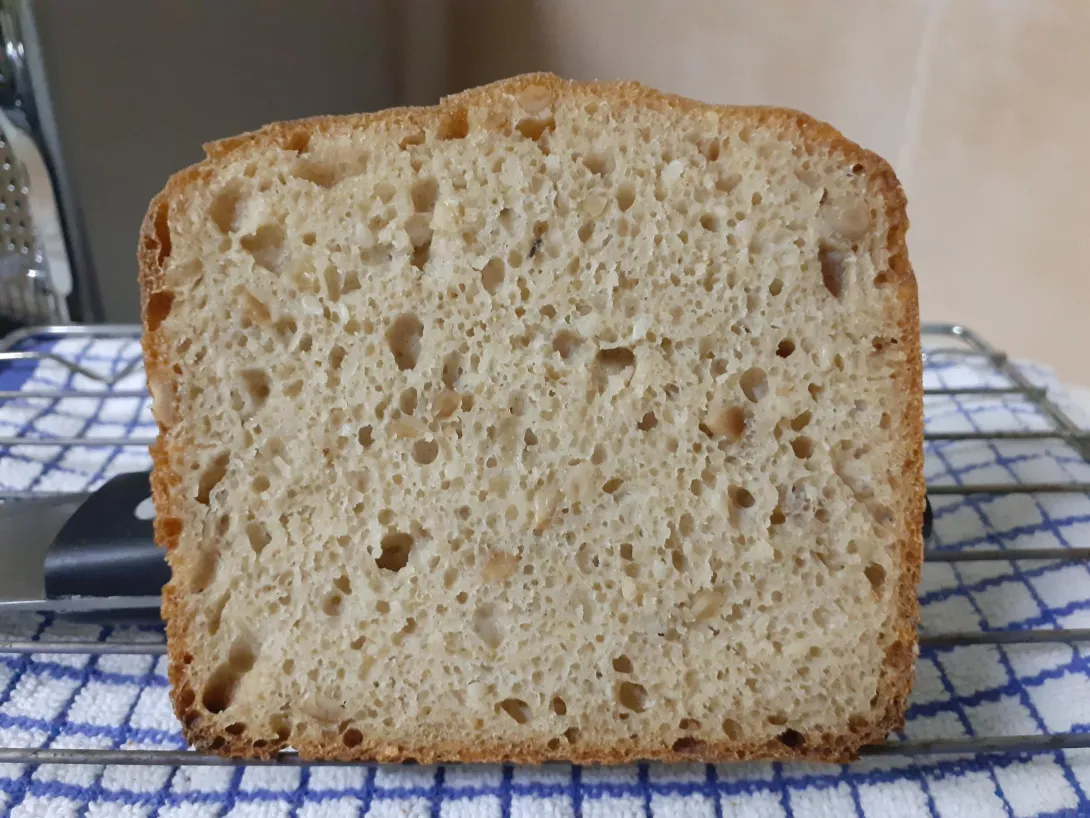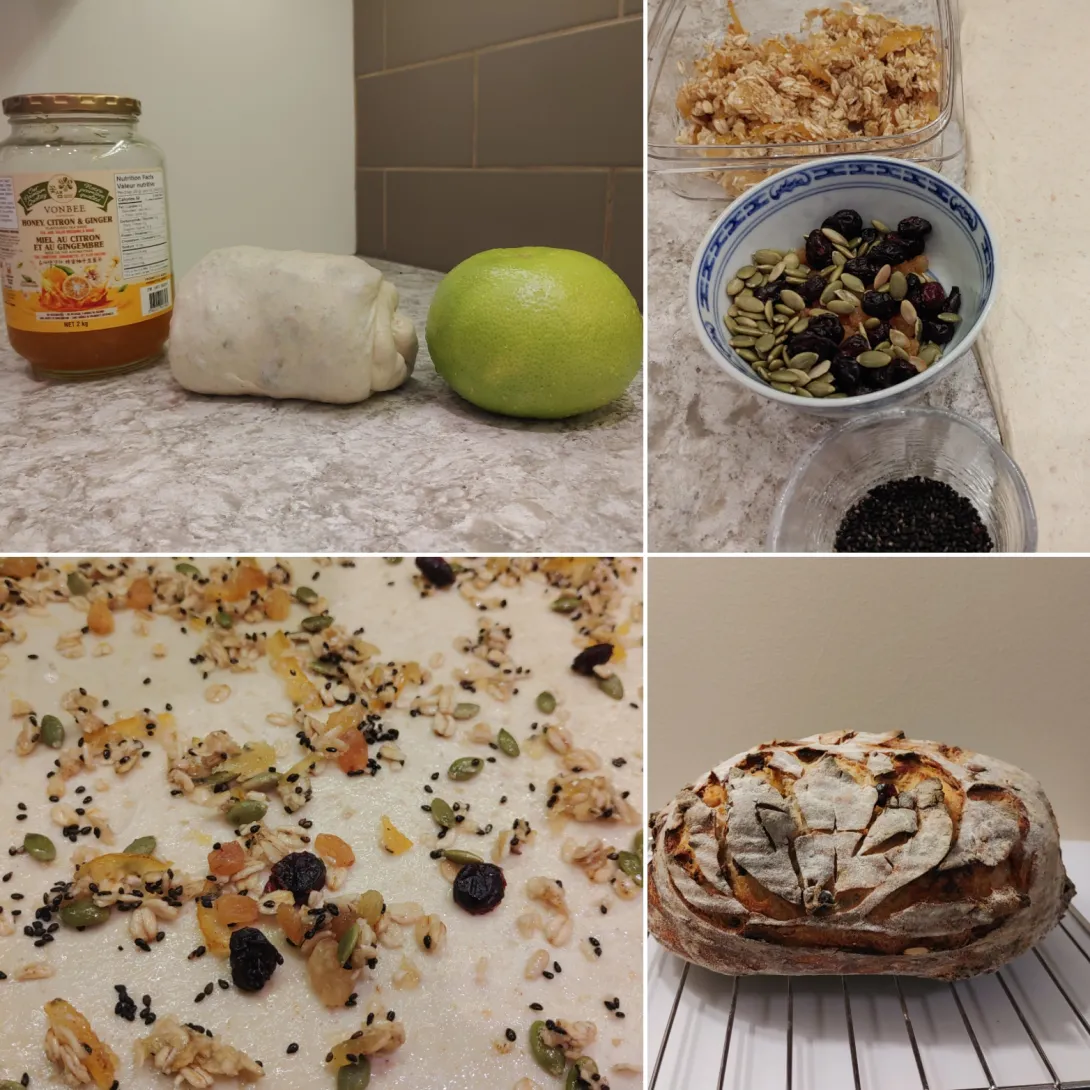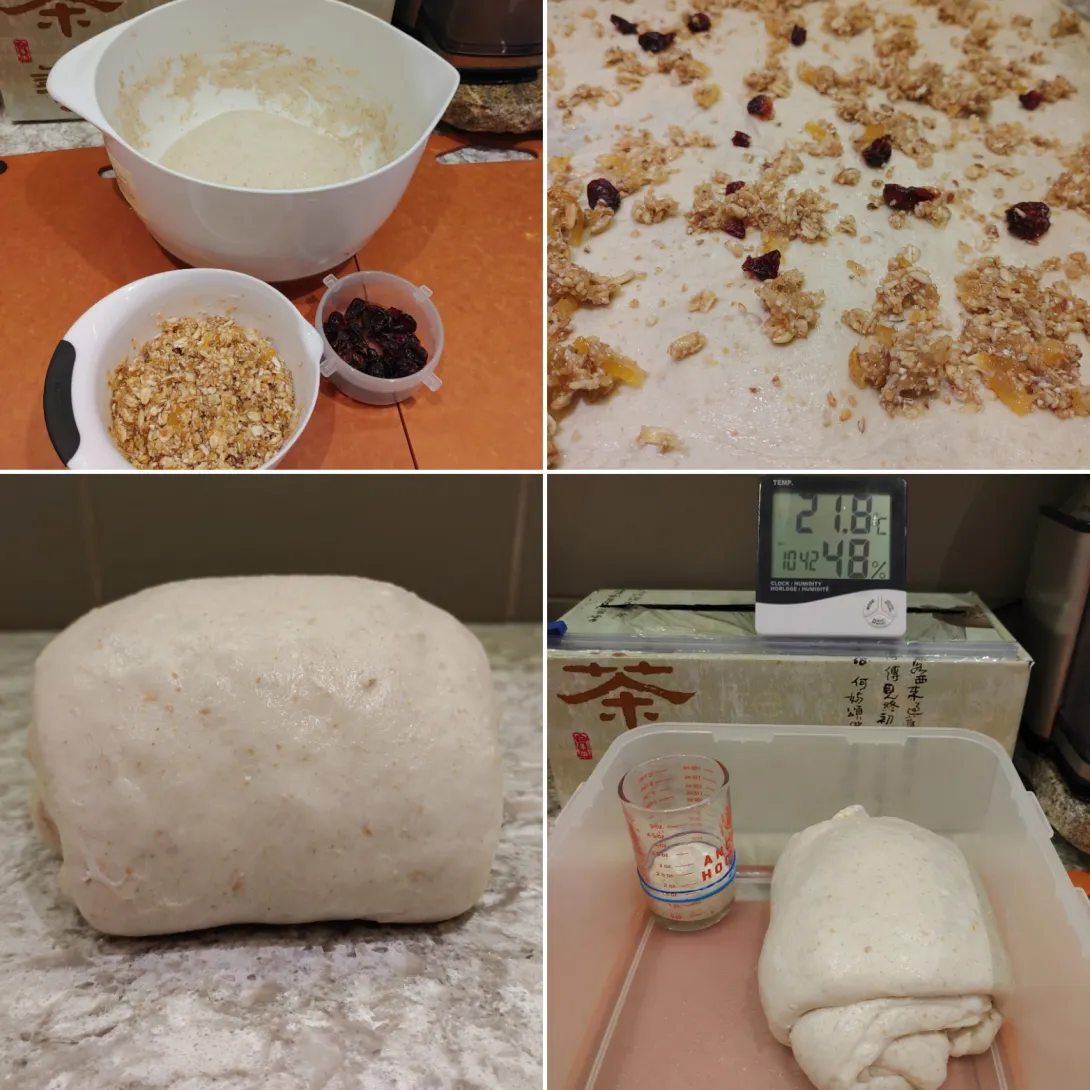
How far i've come from thinking refreshed starter caught at its peak makes the best bread. Sometimes it does one good to throw away the rule book, and recipes for that matter, and just have some fun. Nice to not be constrained by convention. So with some ends of packets and un-refreshed starter I came up with something along these lines...
- 550g flour (about 250g bread and durum mix, 250g wholegrain kamut and 50g wholegrain rye)
- 467-495g (85-90% hydration) water
- 11g salt
- Toasted sunflower seeds
- Sesame seeds
- 3g un-refreshed 120% hydration wholegrain rye starter (been sitting in the fridge for a few weeks)
Everything is a guesstimate with making a few mental notes on the way while pouring flour in the bowl then working out the dough hydration, after going by feel, by working out the difference of the flour and bowl plus add-ins.
Bulk ferment was 16 hours getting in some folds along the way. The dough developed very well. Sticky but manageable. At the end of the bulk ferment it had risen by about 2.5x. Final proof was 1.5 hours and baked in a pullman.
Really delicious. Texture for more than 50% wholegrain with kamut and rye to-boot is excellent. Flavour is delicious. With the kamut bringing out some tang but the durum balancing it out. Rye giving a lot of depth of flavour and bread flour lending some lightness. Best of both worlds. Sunflower seeds and sesame seeds are very delicious with the toasting drawing out the oil adding to the texture as well.

That’s a great looking slice, Abe. The crumb is very nice.
I love the artistry involved in free form breads. But as of late, pullman pans are getting the lions share of my doughs. The slices are perfect for eating...
Pullman Pans -
Have you ever worried about over filling a covered pullman?
I did just that (by accident) this week.
The dough squeezed out of the pan, AND the bread (by accident, AGAIN) baked 90 min. In spite of all mishaps the bread made for some great eating. To my surprise - taste, texture and all - exceptional.
Have you see THIS?
Covered Pullman Pans are able to cover a multitude of sins :-)
I agree with you 100%. I also love the free form artisanal loaf when it comes to looks but it can't beat a Pullman when it comes to slices. The first and last slice being as good as the middle. Not much one can do with ends of free form loaves. Sandwich loaves are very uniform and practical.
Thanks for the link Dan. Just had a look and all I can say is been there done that ?
Still, once you've cut off the lava flow you're left with a perfect loaf. Mainly happens with more liquid doughs and when the pan has been filled too much. It took me sometime to get used to it but I can guage now how much dough depending on flour and hydration. This one was slightly under for a flat top but I don't mind it having a dome as long as it's baked well and it's practical for eating. The biggest problem with an overflow is not the loaf but cleaning the oven.
That's a great looking crumb Dan. You've got the crumb of an artisanal loaf with the slice of a sandwich bread.
Gotta agree with Dan, that crumb and loaf are excellent. I’d love to have a slice of that for toast with my Yuzu marmalade for breakfast. Love that you put it together going by feel.
Benny
A lot going on by way of flavour. I do love a high percentage levain in a bread like in a Hamelman recipe. But I think these slow rising breads also have a lot to offer. Sometimes I buy too much flour of different grains but then end up with ends of packets. Nice to use them up in an off the cuff recipe and see what you get. One sometimes gets to discover a nice combination. I think kamut and rye go well together. Now I've seen yuzu in the supermarket but comes in a small bottle like a vanilla extract. How would one use it? Or yuzu it?
I recently found what they call Citron Tea in a local Korean grocery store near me. In fact it is Yuza which is the Korean name for Yuzu. It is essentially a marmalade made with honey and yuzu. When I was in Japan early winter 2019 I had Yuzu tea at Starbucks and I’ve been trying to figure out how to make it now that I’m home. I was poking around the Korean grocery and noticed bottles of what looked like marmalade and decided to read the label. That is when I discovered that they were essentially yuzu marmalade and the Koreans use a few tsp of it with boiled water and drink it as a tea. OMG it is delicious. I’m trying to think of how I might eventually use this in bread of some sort. Anyhow, other than drinking it, I’ve used it as a marmalade on my toast and was thinking that your bread would be great with it for breakfast.
So yuzu is citron! You've just reminded me I've seen it in my local Korean store and it's sold as tea. Comes in a jar and you add it to hot water. So you use it as a spread and treat it like marmalade? I've seen aloe vera and ginger versions too. I've actually thought about buying it but after looking at the label saw the sugar content was very high. But perhaps I should buy a jar and see what it's like.
I've actually used marmalade in rye bread before. Instead of putting zest of orange in the breadtopia rye recipe I used marmalade instead. Works a treat. Gave great flavour and texture. Wrote the method down as well for future use.
Well isn’t that an interesting idea, I’ll have to have a look at that recipe. Go buy a bottle of the Yuja/Yuzu/Citron tea. It’s not pricey and it does make awesome tea especially if you’re like me a love yuzu. It is such a unique flavour Abe.
Hi everyone, first time posting on this forum, learnt a lot in the past 10 months reading all the tips from all bread making enthusiasts!
I am based in Toronto, Canada and always love visiting the Korean grocery stores to get Yuzu citrus Preserves for drinks, and lately found a good quality Yuzu Preserves sold at Costco. I have tried baking with Yuzu several times, and found it very refreshing in sourdough bread. Here's a picture of the last one I made and I like presoaking the yuzu with rolled oats to absorb the liquid from the preserves. I am still learning on making sourdough bread and taking pictures with my cell phone on food so bear with me if the pictures are not clear.
Image

That's a beautiful looking Loaf. Mixing marmalade with rolled oats, clever! It looks like you're making a swirl or not?
I have been following the tips and techniques of Kristen Dennis of FullProofBaking and used the Lamination stage to incorporate the inclusions then rolled the dough to continue the bulk fermentation. Here's the picture of my other bake with citrus Preserves. It was fun!
Image

Hello fellow Torontonian. I just recently discovered the Yuzu/Yuja tea at the H Mart near me and I have drinking it, a lot. I was thinking about using it for my bread and I love your idea of using it with the oats. The flavour of the yuzu is so unique and delicious, how did you enjoy the flavour of your bread? Do you have any photos of the crumb?
Benny
Thanks Benny.
Hate to hijack Abe's post, so when I have a moment will start learning to create posts on my blog to welcome comments from everyone.
Amy
My mind launched off to using any sort of marmalade. Lemon comes to mind too. Yum!!
Looks amazing Abe, and I bet it tastes delicious. Particularly impressive for such a spontaneous recipe, wish I had the ability to through a dough together with whatever I have in the pantry and get bread like that!
I'm more confident in you and know you can. Try it. I do use scales for the flour if only to know the size of dough I'm aiming for. And salt too as I like to get that accurate but everything else is by feel. I probably could do everything scale-less and get everything in proportion to each other but might be too much or too little dough. If I was doing a free form dough that wouldn't be an issue. Then I wouldn't scale it at all. It's only because I'm using a Pullman.
Method is to put the bowl on the scales and pour the flours in. Do any old mix as that isn't important. Get inventive and use up what you have in stock. Add in 2% salt. Then for the starter just use any amount you wish and add in water slowly stopping when it feels right. Dissolve the starter in a bit of water too if using a very small amount so it mixes easier. That's it. You can totally eyeball add-ins which is what I did.
You have a good idea of how long it'll take depending on how much starter.
It's fun, exciting and a learning experience.
Thanks Abe, that totally makes sense. I've tried doing something similar a couple of times, but the results were a little hit and miss. Definitely good learning process! In general I prefer to plan out the whole recipe, and then maybe adjust the hydration if if doesn't feel right how I planned it. This way also helps to have good notes at least for the formula to see what could have gone wrong. But with practice I'll hopefully get more experience and confidence to just mix things up as I go along.
When the cupboard needs emptying. Don't like half packets of flour here, quarter packets of flour there. Trouble with following a lot of different recipes using different flours is you always end up with small amounts of unfinished flour just pileing up. Then I get the urge to do a bake like this. Often you get a nice surprise which will help form good ideas for your next planned bake. Now I know that kamut with some rye compliment each other. And that toasting sunflower seeds extracts the oil which also adds a nice texture to the bread.
Fun, fun, fun. I now can't wait until I have a few nearly empty bags of flour, seeds and nuts to try to create a reasonable loaf of bread. Thanks, Abe.
Richard
That's the only instruction of this recipe. Throw everything in a bowl and see what you can come up with.
Thank you Richard.
P.s. when using unfed starter it is best to use a small percentage and go for a long ferment. Using a high percentage of old starter produces less than desirable results. If you wish for a higher percentage of starter then better to feed it first.
Great looking slice of bread! It's fun to experiment and even better when it turns out good. Sounds and looks like it was a good bake!
This one certainly turned out well. Nice combination of flavours and a good lesson about starter.
I'm about to do something similar with roasted chopped green pumpkin seeds. I need to come up with a name for the bread if asked what I'm baking. If it doesn't have a name, it looks like an experiment, hubby tends to give me a skeptical raised eyebrow.
Let's see, first the name of a location (any location, with my husband, the farther away, the less experience he's had with that location's bread) then maybe a Saint's name (check a name calendar) and the main flour in the recipe. The green pumpkin seeds come from Steiermark, the main flour is spelt/dinkel, and today's name day is "Leander," tomorrow is "Roman." So if hubby asks, it's "Steierishes St. Leander Dinkel Bread." Which sounds like I'm following an established recipe. Shhhhhh. ;)
Feb 25th was Walpurga..(or a variant) and Feb 24 Matthias/ Mathew for ideas
How would you name your loaf?
That'll be the name of a famous bread. Now what should I call mine? I'll put my thinking cap on. Looking forward to see how your Steierishes St. Leander Dinkel Bread turns out.
Thank you Mini.
Soft crumb. Only the slightest tinge of green, more golden in color. Needs a few more tweaks. So far a good bread. Notice how the top slice bends over the slice below it.
Crumb does look soft and delicious. I'm all for toasting pumpkin seeds so they pop a little, have more crunch and flavour. Colour of the crust is good. I like a bold bake. Does your husband approve?
he ate only one slice. But last light I made french toast (soaked slices in egg-milk and fried in butter) ate one big slice :) and left a big slice in the pan overnight. This morning it was gone! It does make a nice french toast. I like the crumb and very happy with the bread but 100g grated raw pumpkin seed was a bit too much, the flavour stepped up the second day and that's what hubby didn't like. He such a plain white bread lover!
Anyway, the loaf keeps well. I did use instant yeast along with 380g mixed white wheat flours, 130g spelt, with about 375g water. Total dough weight was about 1025g. Next time I'm roasting the seeds as you suggested and using sourdough, and stepping up the salt just a tiny bit. I might cut half the pumpkin seeds with ground hazel nuts. No scoring of the top. I thought before scoring it didn't need it, but did it anyway, just to see the result.
He keeps calling it "That Steier loaf." I will tell him he was right, forgot to roast the seeds, missed that note so he keeps thinking its a "real recipe." Will it come out the same color? Toasts up nicely. Slices almost too wide for my toaster. I used my large Wilton steel pan (9.25 x 5.25 x 2.75 inches or 23.5 x 13.3 x 6.99cm)
Mini
Tells you he's not fond of it but all the same you find it disappearing. As for the pumpkin seeds I use the green shelled ones, leave them whole and dry roast them in a pan on a low flame till they have a nice aroma and a lot of them have popped. You may have to every so often gently shake or rose the seeds so they don't burn and get evenly roasted. Really brings out the flavour and improved the texture in the final loaf.
Give it a few years and the Steier Bread will be a thing. Perfect the recipe and spread the word!
kept the loaf from turning out heavy. With the last little bit of loaf (still moist) I trimmed off that lovely crust. Fifty grams crust; boiled, cooled to feed my next levain (or maybe not going straight into the dough with a tiny pinch of culture.) The crumb got cut into little squares and toasted with onion and garlic in bacon drippings for some soup croutons.
That's a great crumb and it is amazing to learn that only a small amount of unrefreshed starter was used!
I've often wondered why a starter should always be refreshed and yet my starter has no issue in fermenting the refreshment. If it doesn't struggle when being refreshed it should make good bread too. I suppose it's done for a few reasons. Firstly, as an assurance it's going to be fine. And secondly, when using a high percentage of starter you want it refreshed for better taste and a stronger final dough. However when using unfed starter in small quantities it should be fine as long as you give it all the time it needs.
I've also used marmalade in rye doughs and it works very well for taste and texture.
So, in other words, if the recipe calls for 200g starter for making a 2.2kg loaf, I should still do several refreshments for levain build, if the starter quantity is a small amount then as long as the starter is healthy, then what you had done had demonstrated a great reference on using a small amount to ferment a loaf! This is exciting to learn something new!
The longer it's been unfed the more acidic it will be with off flavours and degraded gluten. So you wouldn't wish t use it in high ratios as it'll affect the final outcome of your bread. In this case a refreshment is necessary and using it when active. It'll balance everything out for a stronger dough and a more flavourful bread. However if unfed then better to use less. If you're sure about your starter and you know it'll perform well then this method is no problem. There's lots of benefits doing it this way too. Each technique brings out different qualities in the final loaf.
If it's been a month or two since the last feed and it doesn't look too healthy then perhaps it'll need some TLC before using but certainly 2 or 3 weeks, it looks fine and it's generally a good strong starter then it'll be fine.